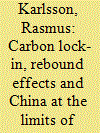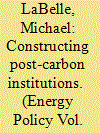| Srl | Item |
| 1 |
ID:
117010


|
|
|
|
|
| Publication |
2012.
|
| Summary/Abstract |
From the beginning, the statist frame of the Kyoto Protocol has invited a focus on national carbon budgets and piecemeal mitigation within rich countries. Despite the Clean Development Mechanism and other efforts to diffuse low carbon technologies to developing countries, China has over the last decades continued to construct hundreds of new thermal coal power plants leading not only to skyrocketing emissions in the present but also to long-term carbon lock-in. In light of this, China is likely to continue to put strong upward pressure on global emissions for many decades to come. Ignoring the seriousness of this situation, many rich countries have persisted to seek marginal improvements to intermittent low-energy sources such as wind power rather than taking the lead in developing breakthrough baseload technologies such as nuclear fusion. This paper argues that only such high-energy technologies, if made significantly cheaper than any fossil alternatives, will be capable of breaking the current carbon lock-in process in China and other developing countries.
|
|
|
|
|
|
|
|
|
|
|
|
|
|
|
|
| 2 |
ID:
111092


|
|
|
|
|
| Publication |
2012.
|
| Summary/Abstract |
This paper examines three different governance approaches the European Union (EU) and Member States (MS) are relying on to reach a low carbon economy by 2050. Current governance literature explains the operational methods of the EU's new governance approach to reduce carbon emissions. However, the literature neglects to account for the perceived risks that inhibit the roll-out of new low carbon technology. This article, through a novel approach, uses a grounded theoretical framework to reframe traditional risk literature and provides a connection to governance literature in order to assess the ability of EU governance mechanisms to reduce carbon emissions. The empirical research is based on responses from European energy stakeholders who participated in a Delphi method discussion and in semi-structured interviews; these identified three essential requirements for carbon emissions to be reduced to near zero by 2050: (1) an integrated European energy network, (2) carbon pricing and (3) demand reduction. These features correspond to institutionalized responses by the EU and MS: the Agency for the Cooperation of Energy Regulators (ACER); European Union Emission Trading Scheme (EU ETS) and energy efficiency directives and policies integrated into existing MS institutions. The theoretical and empirical findings suggest that governance by facilitation (energy efficiency) fails to induce significant investment and new policy approaches and cannot be relied on to achieve requisite reductions in demand. Governance by negotiation (ACER) and governance by hierarchy (EU ETS) do reduce risks and may encourage the necessary technological uptake. The term 'risk governance' is used to explain the important role governance plays in reducing risks and advancing new technology and thereby lowering carbon emissions in the energy sector.
|
|
|
|
|
|
|
|
|
|
|
|
|
|
|
|